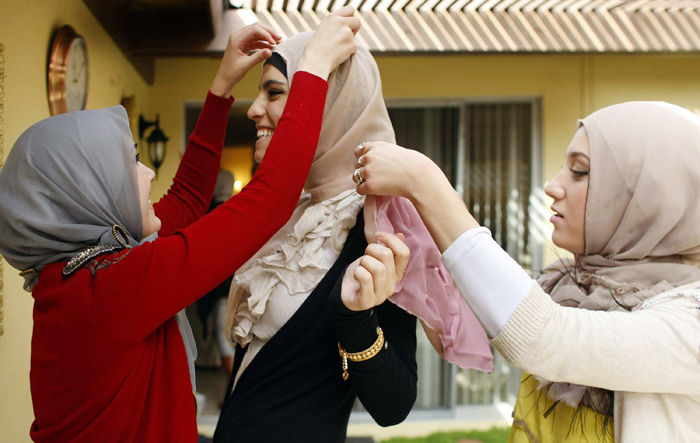Feminism of the hijab
The hijab is a symbol of cultural identity, the understanding of which starts at the individual level. Friends Nora Diab, left, and Marwa Atik, right, adjust a new hijab on friend Marwa Biltagi in the backyard of Atik’s home in Fountain Valley, California.
September 23, 2015
The most hotly-contested piece of clothing in our modern society is not the thong, bikini, crop top or miniskirt – it is the hijab.
In multiple European countries, there have been legal bans enacted against it, and intense debates have raged about its supposed purpose to oppress Muslim women, with some politicians even calling into question the national loyalty of Muslim women who wear a hijab.
The hijab is not a symbol of oppression, nor does it oppress the wearer. The hijab is part of a very important kind of feminist politics that have been all too ignored in Western conversation.
Simply put, the twisted perception that has been provided by sensationalized Islamophobia has been prioritized over the actual lived truth of millions of Muslim women.
The truth of the matter is that “for many Muslim women, wearing the headscarf has become a feminist act, serving as a symbol of their identity and a way to counter cultural imperialism,” according to the Public Broadcast Service. “Muslim women are defining and developing feminism — on their own terms.”
The politics of the hijab are complicated by the fact that there are many women who are forced to wear the hijab in certain countries – sometimes through violence.
This kind of practice is one that is not representative of the kind of environment that women should be operating in. However, it is important to note that the policing of women’s bodies crosses borders and is translated into different forms, just as much as we transition into different languages as we cross time zones.
Thus, it is important to consider the perspectives of those who come from specific identities that are less understood. The conversation needs to be opened further than the assumptions that have been generated to ostracize and separate.
“Some might say there’s nothing inherently liberating in covering up, just as there’s nothing inherently liberating in wearing next to nothing. But the liberation lies in the choice,” said Muslim feminist Hanna Yusuf, who wears a hijab, in a video testimony on Everyday Feminism.“By assuming that all veiled women are oppressed, we belittle the choice of those who want to wear it. Even when women are vocal about wanting to wear the hijab, they are conveniently unheard or silenced.”
I do not deny the reality of the atrocities that are committed in countries that enforce mandatory wearing of the hijab through violence.
However, women that wear the hijab are being exposed to different forms of violence at the hands of those who do not understand the politics of their religion and their identities.
One of these is violent physical attacks on women who wear the hijab – the number of attacks on the Muslim hijab and women who wear them have been on the rise in recent years.
This is an issue that concerns the global community – in London, there has been a “70 percent increase in the number of attacks recorded between July 2014 and July this year compared with the previous 12 months (against Muslim or Muslim-perceived people),” according to the Daily Mail. “Around 60 percent of victims are women who wear a headscarf or hijab.”
It is crucial that Westerners step up as global citizens to attempt to understand other cultures and religions – not just the ones that we are comfortable with – in order to protect those who are marginalized and suffer the effects of such treatment.
So, I have a proposal: challenge yourself to not just learn more about the hijab, but about Islam itself. Step outside your comfort zone.
It’s time to truly unveil (pun intended) the politics of the hijab and the Muslim experience, and see the truth for ourselves.
It is because we are not doing this that persons like Ahmed Mohamed are being accosted daily in America and elsewhere, and that women who wear the hijab are being attacked. Cultural literacy is necessary in our society, and it starts at an individual level.
Sophia Stephens is a senior english literature and comparative ethnic studies major from wenatchee. She can be contacted at 335-2290 or by [email protected]. The opinions expressed in this column are not necessarily those of the staff of The Daily Evergreen or those of the Office of Student Media.









